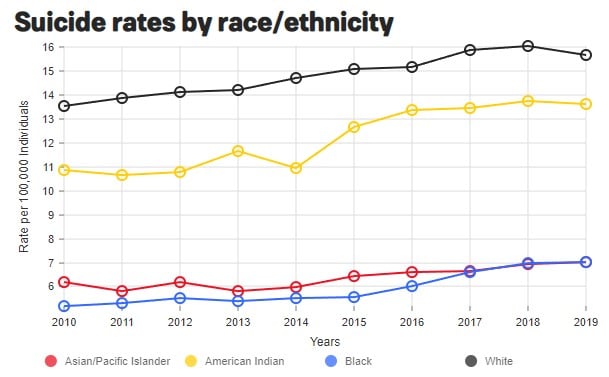Why World Mental Health is Getting Worse
For every hundred deaths, one is caused by suicide.[1] The numbers go even higher for those who try to take their own lives.[2]
The Centers for Disease Control and Prevention (CDC) has dubbed suicide as one of the top reasons people die. Thus, it has already become a significant public health concern.[3]
It’s crucial to take any mention of suicide seriously even if not all suicide-seeking behavior is intended to kill. Sometimes it is more like an invitation for mental health support. They’re not fully committed to seeing it through.[4] For example, a patient called Dr. Alok Kanojia or another friend after she overdosed on pills to let them know what she did.[5] A study found that talking to the person about the matter and using active listening can help reduce the risk of suicide and give them hope.[6]
There is a big chance of preventing suicide or a suicide attempt. Most people who think about it may feel hopeless about what’s happening to them. Often, they send some form of warning to the people around them before attempting to take their own lives.[7] For example, someone mentioning a desire to die, searching for potentially dangerous weapons and suicide methods, and pushing away friends and family.[8]
Who is Most Likely to Commit Suicide?

It is estimated that 13 people out of 100,000 each year commit suicide.[9] Sadly, many of those that attempt suicide may even go unreported. From what we’ve learned, suicide is much higher in specific groups than in most.
More women attempt to die, but more men die
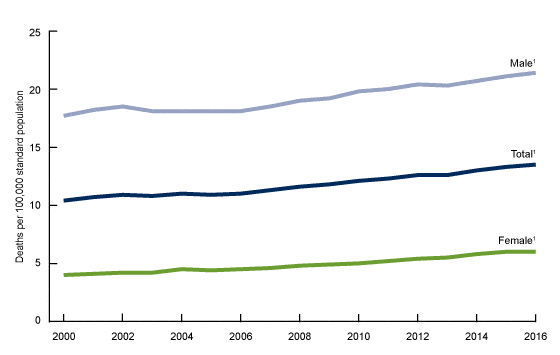
More adult women attempt suicide than men, but they are less likely to complete it.[10] Research has shown that 4 out of 5 suicides are men.[11] This is probably because men choose more deadly methods.[12] For example, men often try killing themselves by shooting themselves with a gun, carbon monoxide poisoning, or hanging. Women, on the other hand, usually poison themselves by overdosing on pills.
Older people
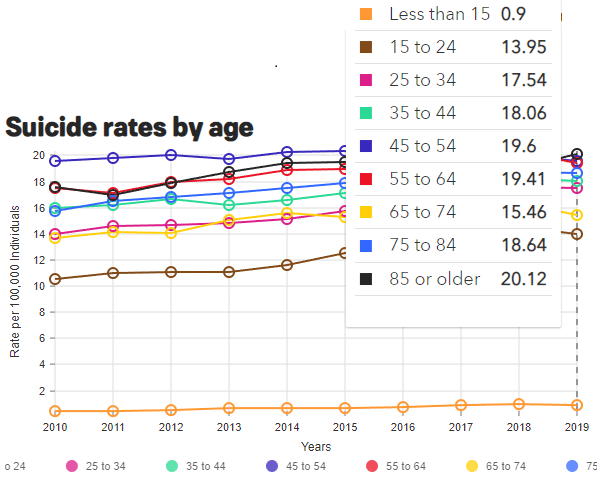
People who are 85 years or older have the highest suicide rates.[13] This is followed closely by the age groups for those 45-54 years old and 55-64 years old.[14]
White
Suicide rates are the highest among those of White race or ethnicity, with American Indians and Alaska Natives as the second highest.[15]
Adolescents who take SSRI
Some adolescents treated for depression are usually prescribed antidepressant drugs called selective serotonin re-uptake inhibitors or SSRI.[16] Researchers have found that adolescents who take this drug are more likely to complete or attempt suicide.[17] Therefore, clinicians need to take extra care and attention during the first few weeks upon prescribing this drug to adolescents.
People who have attempted suicide
Survivors of suicide attempts are at the most risk of committing suicide. However, younger groups will most likely try again if they have either a case of alcohol use disorder or a personality disorder.[18]
There is nothing set in stone to predict who will choose suicide. These are just some of the common statistics from those who have attempted or completed suicide.
It’s believed that someone decides to take their own life because they are mentally ill
Surprisingly people who take their own lives do not have a diagnosed mental illness in many cases.[19] There can be many reasons for choosing suicide. For example, they can be undergoing a tumultuous time in their life, like a physical illness or experiencing work problems.
Remember that there is not only one single culprit. It can be a combination of other things as well.
Why People Commit Suicide

Mental illness and psychopathology are not the only reason why people take their own lives. They can stem from different causes and it is crucial to remember that suicide is related to many other things.[20]
Having this approach will help us understand that suicide is not an illness but a symptom of something else. We list down several reasons below why someone could be considering suicide.
1st Reason: Mental Illness
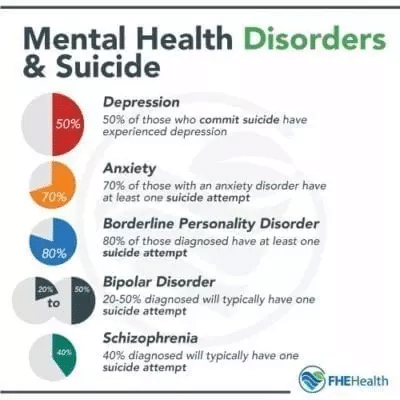
People suffering from mental disorders fall into this category. There is a greater risk for those who have depression, problems with substance use, and psychosis.[21] Suicidal behavior is also typical among people who suffer from anxiety disorders and personality disorders.
Major depressive disorder (MDD) is commonly found in people with suicidal thoughts. It is often characterized by the statement “I’m suicidal despite life being great.”[22]
2nd Reason: Loss of the ideal self-state or ‘broken life dream’
People will usually have a good idea of what they want themselves to become. However, some events may break that idealized version of their lives, leading them to think that suicide is the only option out.[23] This destructive life event can even trigger a major depressive episode.[24]
An example of a ‘broken life dream’ can be a person who was accused of sexual harassment and fired from their job. He is ostracized from the community even without any proof that he is guilty or innocent. He may entertain suicidal thoughts and behavior because of his experience.
Another example of this is when a woman wants to have a child but cannot bear children. Despite trying different methods, her body miscarries several times. She may then consider suicide as a way out of her situation.
This category is characterized by the statement, “Life isn’t worth living (hopelessness).”[25]
3rd Reason: Sudden defense breakdown
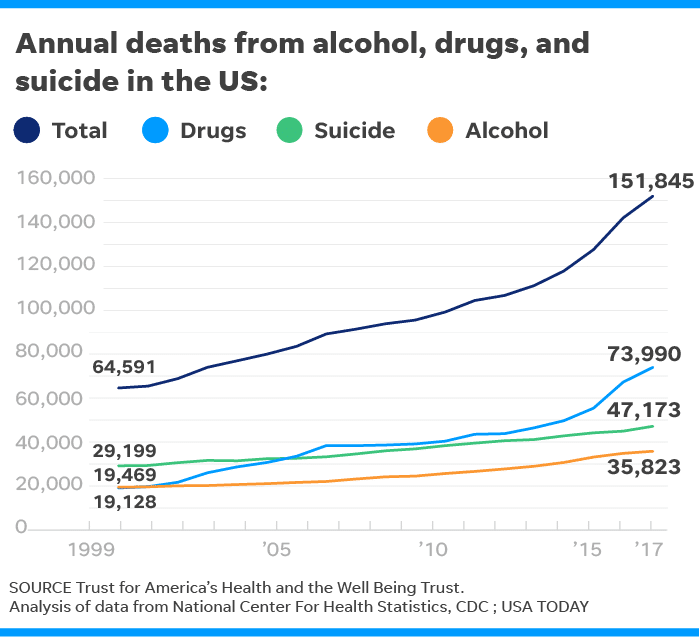
As mentioned above, one doesn’t need to have a mental illness to have suicidal thoughts. Some people may have suicidal thoughts, but one’s mind holds the pro and anti suicidal ideas in check. There can be occasions when the balance tips and the defense from suicidality fail. Usually, it involves some substance that affects your state of conscience.[26]
An example of this is when one uses alcohol. The chemicals lower one’s control, making it easier to entertain suicidal thoughts without any defenses. It may, unfortunately, end in a suicide attempt.
4th Reason: Anger turned against self with revengeful intent
Some people may choose suicide as a way of expressing their anger towards themselves. This concept is backed up with Freud’s theory that explains suicide as “one’s aggression towards the self.” One feels that life isn’t worth living anymore and one doesn’t deserve to live at all. In committing suicide, one thinks they are sufficiently punishing themselves for being bad and not deserving to live and get better.[27]
This category is captured by the statement filled with anger: “I don’t deserve to live.”[28]
5th Reason: Intolerance of humiliation, envy, and shame
When one cannot control their negative emotions, there is a big chance that person will entertain more suicidal thoughts. [29] A person who cannot successfully manage their negative moods and respond well to their situation is called emotional dis-regulation.[30] Poor coping strategies can lead a person to feel ashamed and humiliated by his experiences.[31]
These are the different reasons why people may kill themselves. It’s not just mental illness that only causes suicide but a combination of several reasons.
There has been a 17% increase in suicide in the Americas Region from 2000 to 2019.[32] The use of antidepressants among adults has also increased between 2009 to 2018.[33] So it may be about time to look at something else that is causing suicidality other than mental illness.
Suppose different causes are considered responsible for suicidality. In that case, there needs to be different solutions to help people who are considering suicide.
We may be able to help more people and prevent further suicides.
How People Commit Suicide

There is no one easy way to predict suicides. Unfortunately, it’s hard to know when someone will decide to do it.
A common myth is that a person who chooses suicide will prepare and get their affairs in order before completing the attempt. There is also the belief that people will only choose suicide when they reach a certain level of distress. They don’t believe that they are in danger because they aren’t planning to kill themselves yet. However, there is a reason to take any suicidal thoughts seriously.
Clinicians have found out that 18 out of 30 people who decided and attempted suicide did so in less than 5 minutes. In addition, not a single person from the sample decided more than 3 days before attempting suicide.[34]
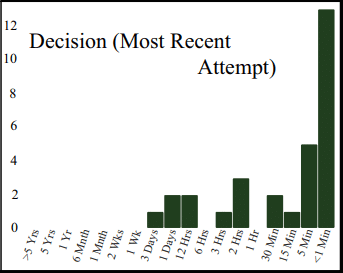
Some studies show that one’s suicidal thoughts can change in intensity and conviction within a few hours.[35] A person may not feel suicidal now but may suddenly feel suicidal less than 4 hours later.
The first thing clinicians look for when a person is deciding on suicide is whether or not they have access to weapons they can use to harm themselves. This is because the window for choosing to take one’s life is so tiny. If a person has a gun at home, then it is easier for them to complete suicide. Making sure that any methods of harm are inaccessible keeps the person safer.[36]
Dr. K assesses his patients’ risk of suicidality by using a scale of risk. It provides a scale to determine how badly the suicidality is at the moment. As a disclaimer, this should, in no way, form the basis of whether one should see a clinician or not.[37]
- “If I went to bed and I never woke up, I’m fine with that” (Passive suicidality)
- “I wish I went to bed and never woke up” (There’s desire but not intent)
- “I’m going to try to not wake up” (Contains intent)
- “I’m going to try to not wake up in this particular way” (Includes the scariest thing, which is plans and means)
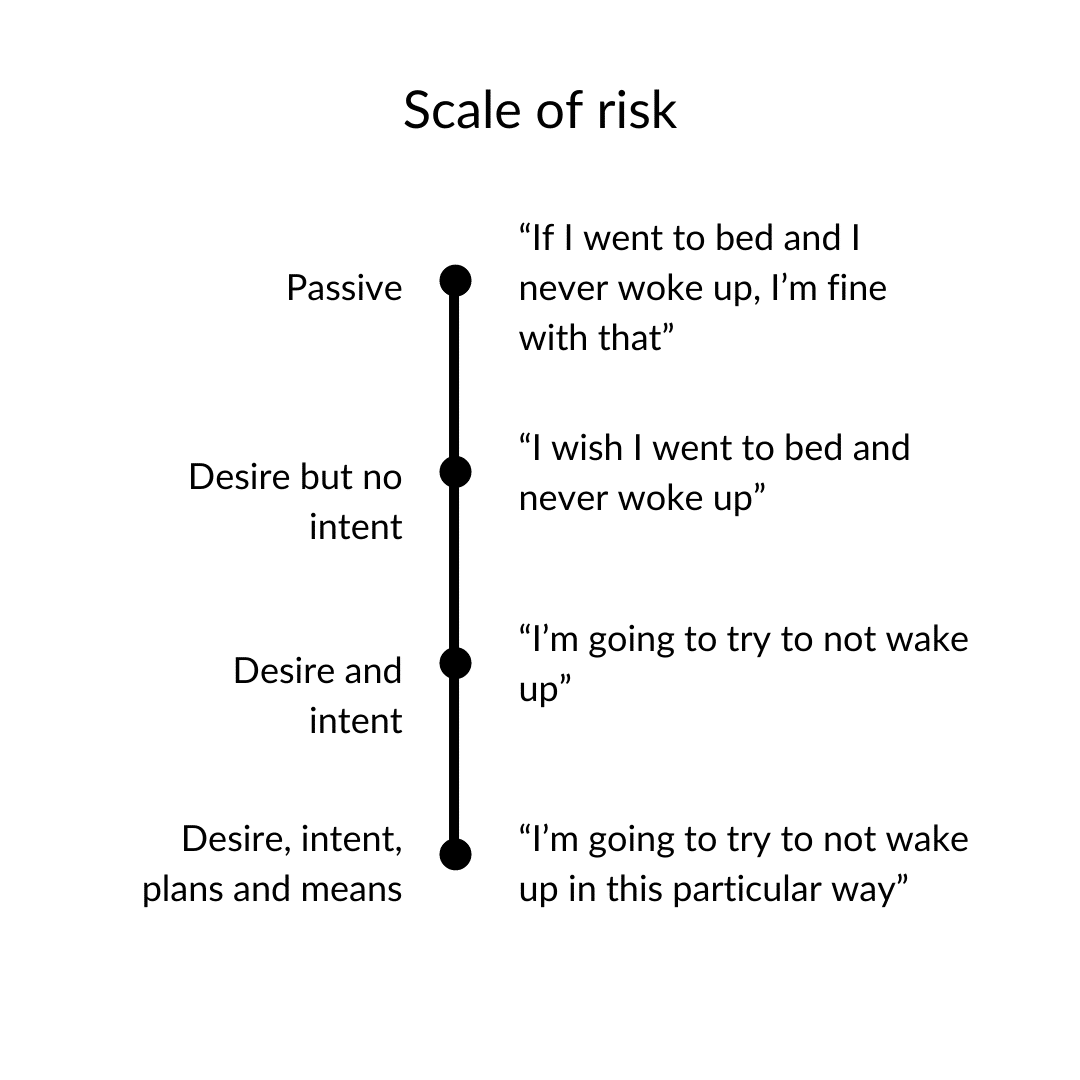
If one finds themselves on any part of the axis above, Dr. K strongly recommends seeking professional help. Even if one doesn’t think they fall anywhere on the scale, they can still go and get evaluated. Know that the mind may sometimes make you believe in things that aren’t true. Like, for example, thinking that your situation is irreparable and nobody else can help you.[38]
Consider situations when you encounter a problem. You will usually seek the appropriate expert in that field. For example, you get a flat tire, you approach a mechanic for help. If you have suicidal thoughts, you seek a psychiatrist who knows how to properly help people with suicidal ideation.[39]
Your life shouldn’t be dictated by your emotions and your thoughts.[40] You may want to listen to them sometimes but not wholly, especially when those thoughts and emotions harm you. Don’t let your mind and emotions control the way you live. Fortunately, there is a big chance helping those at risk through the help of trained and licensed professionals.[41]
How to help someone else that’s dealing with Suicidality

If you think you or anyone you know are experiencing any suicidal thoughts or behaviors, please seek help immediately. It is not normal to consider suicide as a solution to stressful situations.[42]
Even if you don’t have any professional training, know that there are some things that you can do to help someone in need.[43]
1. Be a friend to them
You may have some fears that you are not adequately equipped to handle suicide. You are absolutely right, and that’s okay. Here’s why. First and foremost, understand that you are their friend. You are not their psychiatrist, and being a friend is the best thing you can do.
It would mean a lot to them if you reached out and supported them. Some studies show that asking someone about their suicidal thoughts does not lead a person to suicide. It may even help the person think twice about what they are doing.[44] [45] [46]
2. Show them you care
As a friend, you can show them that you are listening and you are there to support them. You can acknowledge what they are going through to show them that you understand. Let them know that you care about them and are concerned about their well-being.[47]
For example, some patients of Dr. K share their traumatic experiences with him. However, because it happened in the past, Dr. K often feels helpless to change the past. He admits to them, “I can’t take this away from you, but I wish I could. I’d like to try to help you in some way. What can we do?” [48]
In doing this, he is sharing in their hopelessness and powerlessness. It’s worth so much to a person knowing that you understand their pain and want to help carry their burden with them.[49]
3. Help them find a professional
After meeting them halfway, you can help them in a practical manner. Offer to make phone calls so that they can get treatment.[50] They may discourage you from finding help due to their hopelessness but let them know that you have a plan to help them until they get in touch with someone.[51]

www.mentalhealthzen.com
These are the things that you can do to help someone dealing with suicide. Remember, you are not their therapist nor a professional; you cannot cure them yourself. However, you are someone who cares deeply for their well-being. As their friend, you are in an extremely valuable position to encourage them to seek help and get treatment.
Suicidal thoughts and behavior may be caused by reasons other than mental illness and psychopathology. Even though many diseases like heart disease and cancer are declining, we are losing the battle against suicide. As a public health concern, each person can play a role in helping those in need.
There is hope for people who are distressed and view suicide as the only option out. The good news is that they can be helped and prevented.[52] Whether the initial help comes from a family member or a friend, as long as they are redirected to properly skilled and trained professionals, it will take them one step closer to getting better.
Again, if you or anyone you know is struggling with suicidal thoughts or behavior, please reach out immediately to a suicide hotline in your area. This website lists down several hotlines you can call based on your location: http://www.suicide.org/international-suicide-hotlines.html
- https://www.who.int/news/item/17-06-2021-one-in-100-deaths-is-by-suicide ↑
- https://www.prb.org/resources/in-u-s-who-is-at-greatest-risk-for-suicides/ ↑
- https://www.who.int/news-room/fact-sheets/detail/suicide ↑
- https://www.medicalnewstoday.com/articles/why-do-people-commit-suicide#risk-factors ↑
- https://youtu.be/AC3AmMIlNbw ↑
- https://www.medicalnewstoday.com/articles/why-do-people-commit-suicide#risk-factors ↑
- https://wmich.edu/suicideprevention/basics/facts ↑
- https://www.medicalnewstoday.com/articles/why-do-people-commit-suicide#risk-factors ↑
- https://www.ncbi.nlm.nih.gov/pmc/articles/PMC4034101/ ↑
- https://www.bbc.com/future/article/20190313-why-more-men-kill-themselves-than-women ↑
- https://www.ncbi.nlm.nih.gov/pmc/articles/PMC4034101/ ↑
- https://www.mentalhelp.net/suicide/statistics/ ↑
- https://www.mentalhelp.net/suicide/statistics/ ↑
- https://afsp.org/suicide-statistics ↑
- https://afsp.org/suicide-statistics ↑
- https://www.fda.gov/drugs/postmarket-drug-safety-information-patients-and-providers/suicidality-children-and-adolescents-being-treated-antidepressant-medications ↑
- https://www.ncbi.nlm.nih.gov/pmc/articles/PMC4034101/ ↑
- https://bmcpsychiatry.biomedcentral.com/articles/10.1186/s12888-017-1317-z ↑
- https://www.cdc.gov/vitalsigns/suicide/ ↑
- https://theconversation.com/why-do-people-die-by-suicide-mental-illness-isnt-the-only-cause-social-factors-like-loneliness-financial-ruin-and-shame-can-be-triggers-131744 ↑
- https://pubmed.ncbi.nlm.nih.gov/29986446/ ↑
- https://youtu.be/AC3AmMIlNbw ↑
- https://www.tandfonline.com/doi/pdf/10.1521/psyc.2008.71.2.169?needAccess=true ↑
- https://www.psychiatry.org/patients-families/depression/what-is-depression ↑
- https://youtu.be/AC3AmMIlNbw ↑
- https://www.drinkaware.co.uk/facts/health-effects-of-alcohol/mental-health/alcohol-and-suicidal-thoughts ↑
- https://www.tandfonline.com/doi/pdf/10.1521/psyc.2008.71.2.169?needAccess=true ↑
- https://youtu.be/AC3AmMIlNbw ↑
- https://bpded.biomedcentral.com/articles/10.1186/s40479-019-0112-5 ↑
- https://journals.sagepub.com/doi/full/10.1177/0033294118781855 ↑
- https://www.tandfonline.com/doi/pdf/10.1521/psyc.2008.71.2.169?needAccess=true ↑
- https://www.who.int/news/item/17-06-2021-one-in-100-deaths-is-by-suicide ↑
- https://www.cdc.gov/nchs/products/databriefs/db377.htm ↑
- https://nocklab.fas.harvard.edu/files/nocklab/files/millner_2016_pathway_suicideattempts_sltb.pdf ↑
- https://psycnet.apa.org/record/2017-20211-001 ↑
- https://bmcpsychiatry.biomedcentral.com/articles/10.1186/s12888-017-1288-0 ↑
- https://youtu.be/AC3AmMIlNbw ↑
- https://youtu.be/AC3AmMIlNbw ↑
- https://wmich.edu/suicideprevention/basics/how-help ↑
- https://youtu.be/AC3AmMIlNbw ↑
- https://www.nimh.nih.gov/health/topics/suicide-prevention ↑
- https://www.scientificamerican.com/article/suicide-prediction-remains-difficult-despite-decades-of-research/ ↑
- https://wmich.edu/suicideprevention/basics/how-help ↑
- https://pubmed.ncbi.nlm.nih.gov/15811983/ ↑
- https://pubmed.ncbi.nlm.nih.gov/24998511/ ↑
- https://pubmed.ncbi.nlm.nih.gov/22548324/ ↑
- https://wmich.edu/suicideprevention/basics/how-help ↑
- https://youtu.be/AC3AmMIlNbw ↑
- https://wmich.edu/suicideprevention/basics/how-help ↑
- https://wmich.edu/suicideprevention/basics/how-help ↑
- https://www.nimh.nih.gov/health/topics/suicide-prevention ↑
- https://www.cdc.gov/suicide/facts/index.html ↑
